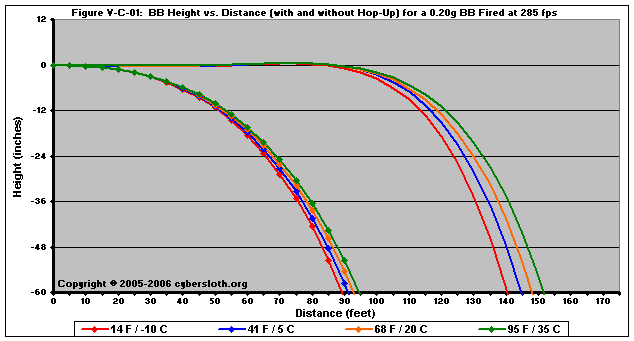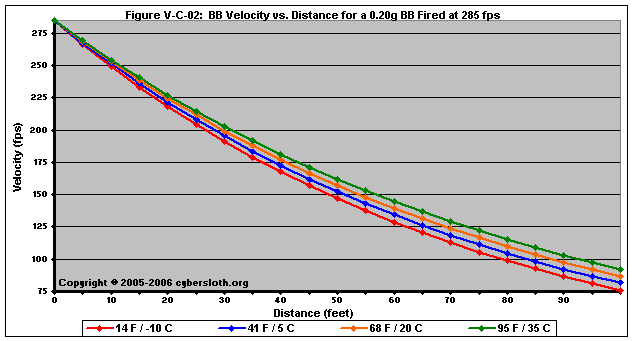Section V-C: Effect of Temperature on Trajectory
Like altitude, temperature is a component of air density. In much the same manner that higher altitudes affect the trajectory of airsoft BB's, warmer temperatures will have a similar effect on the BB.
Cold air has a higher density than that of warm air. This affects the trajectory in two important ways. First, the BB is moving through a denser medium (compared to warmer air). Because of this, the BB will experience more drag along its trajectory in colder air, essentially reducing its trajectory. Additionally, while the denser air offers more mass for the momentum shift that would cause greater Magnus Lift, the denser air also causes the spin rate to decay more rapidly. The faster-than-normal spin decay ultimately limits the lift generated down range. This translates to a lessened trajectory for BB's fired in colder weather, regardless of whether they are fired with hop-up or without hop-up.
Figure V-C-01 shows BB height vs. distance for 0.20g BB's fired at 285 fps. As is clearly shown, warmer temperatures allow for longer trajectories. Ultimately, though, the difference is negligible. Even in the case given, the trajectories would be so similar out to 100' that the shooter would be unable to notice a difference.

Figure V-C-02 shows the velocity decay versus distance. As expected, the BB's that are moving through the colder air experience more drag and ultimately have a lower velocity at a given distance. At a distance of 100 feet, a 0.20g BB fired at 285 fps will be moving at 110 fps in 95 degree weather. In colder weather, drag will have diminished the velocity more so. At 100 feet, a BB fired in 14 degrees will only be moving around 90 fps.

Diminished velocity translates into diminished impact energies. At a distance of 30 feet, a 0.20g BB fired at 285 fps will have an energy of 0.42 J in 95 F weather. By comparison, the same BB fired in 14 F weather will have an energy of only 0.38 J. Nevertheless, the disparity in energy between BB's fired in cold weather versus those fired in hot weather is negligible.

Keep in mind that these are theoretical explanations -- temperature has other effects on an airsoft rifle's performance. The difference in air density changes the compression in the cylinder during firing for AEG's and BAR's, while a colder ambient temperature diminishes the energy released from gas-powered rifles and pistols.
Ultimately, while altitude variations do translate into noticeable differences in trajectory and impact energies, the effects of temperature are relatively small. Keep in mind that it is only in extreme temperature differences that the effects are noticeable.